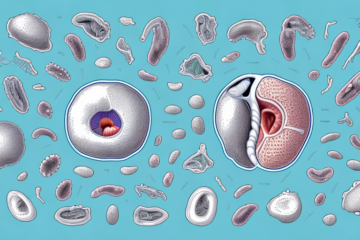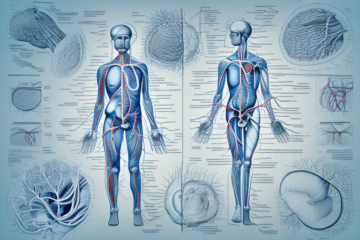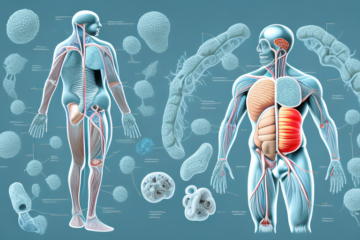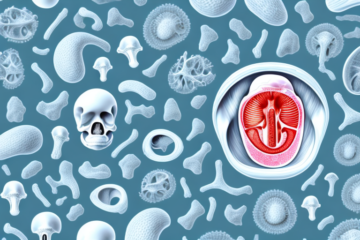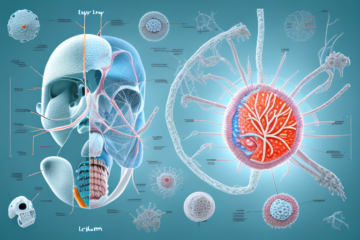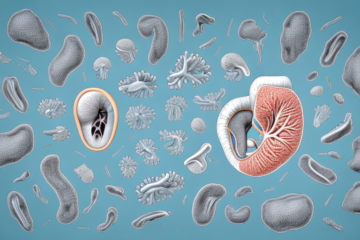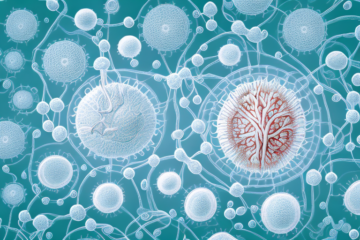Our body is an intricate system of various parts, each of which plays a crucial role in ensuring the smooth functioning of our body. One such vital element is tendons. Tendons are fibrous connective tissues that attach muscles to bones and allow the movement and mobility of body parts such as arms and legs. In this article, we will discuss the function, anatomy, common injuries, treatment strategies, and much more related to tendons.
What are tendons and what is their function?
Tendons, as mentioned earlier, are a type of fibrous connective tissue that connects our muscles to bones. Tendons play a crucial role in facilitating movements such as walking, running, and jumping. Without tendons, our muscles would not be able to transfer the necessary force required for such movements and the bones would not move in sync. In short, tendons act as a bridge between muscles and bones, allowing us to perform functional activities with ease.
It is important to note that tendons can also be prone to injury, especially in athletes or individuals who engage in repetitive activities. Tendonitis, a condition characterized by inflammation of the tendon, is a common injury that can result from overuse or improper technique during physical activity. It is important to properly warm up before engaging in physical activity and to seek medical attention if you experience any pain or discomfort in your tendons.
Anatomy of tendons: structure and composition
Tendons are composed of dense collagen fibers that tend to be organized in a parallel fashion. These collagen fibers provide strength and support to tendons. The outer layer of tendons, also known as the epitenon, is responsible for providing protection against external harm or injury. The epitenon is covered by the inner layer, also known as the endotenon that contains blood vessels and nerve endings that are essential for the repair mechanism of tendons.
In addition to collagen fibers, tendons also contain other proteins such as elastin and proteoglycans. Elastin provides elasticity to tendons, allowing them to stretch and recoil. Proteoglycans are responsible for maintaining the water content of tendons, which is essential for their proper functioning. Tendons also have a poor blood supply, which makes them prone to injuries and slow healing. Therefore, it is important to take proper care of tendons and seek medical attention if any injury or pain is experienced.
How do tendons differ from ligaments?
Tendons and ligaments are both types of connective tissue but they differ in function and structure. Tendons, as mentioned earlier, connect muscles to bones, while ligaments connect bones to bones. Ligaments are composed of elastic fibers and are more flexible than tendons. However, tendons are stronger and hence, can withstand greater forces and stress.
Another key difference between tendons and ligaments is their blood supply. Tendons have a poor blood supply, which means they take longer to heal when injured. Ligaments, on the other hand, have a better blood supply, which allows them to heal more quickly.
In addition, tendons and ligaments have different levels of mobility. Tendons are relatively immobile and only allow for movement in one direction, while ligaments are more mobile and allow for movement in multiple directions. This is why ligament injuries, such as sprains, are more common than tendon injuries.
Common injuries of the tendon
Tendons, like any other body tissue, are susceptible to injuries. Repetitive strain, overuse, and sudden stress can cause tendon injuries. Some of the common tendon injuries include tendonitis, which is an inflammation of the tendon, tendon tears, and tendinopathy, which is a degenerative condition that results in a gradual breakdown of the tendon.
Tendon injuries can occur in any part of the body where tendons are present. However, some areas are more prone to tendon injuries than others. For example, the Achilles tendon, which connects the calf muscles to the heel bone, is a common site of tendon injuries. Similarly, the rotator cuff tendons in the shoulder are also prone to injuries, especially in athletes who engage in overhead activities like throwing.
Preventing tendon injuries involves taking certain precautions. Maintaining good posture, using proper techniques while exercising or playing sports, and gradually increasing the intensity and duration of physical activity can help prevent tendon injuries. Additionally, taking adequate rest and allowing the body to recover after physical activity can also reduce the risk of tendon injuries.
Causes and risk factors of tendon injuries
Tendon injuries can be caused by various factors such as age, overuse, improper technique, and sudden stress. Besides, certain medical conditions such as rheumatoid arthritis and diabetes can increase the risk of developing tendon injuries.
Additionally, lifestyle factors such as smoking and poor nutrition can also contribute to the development of tendon injuries. Smoking can decrease blood flow to the tendons, making them more susceptible to injury, while a diet lacking in essential nutrients can weaken the tendons and make them more prone to damage. It is important to maintain a healthy lifestyle and take preventative measures to reduce the risk of developing tendon injuries.
Diagnosis and treatment strategies for tendon injuries
If you suspect that you have a tendon injury, it is important to visit a doctor for a proper diagnosis. The diagnosis will typically involve a physical examination, imaging tests, and evaluation of medical history. Treatment strategies for tendon injuries may vary depending upon the type and severity of the injury. Rest, ice, compression, and elevation are some of the initial steps that are taken to alleviate pain and inflammation. Physical therapy, medication, and in severe cases, surgery, may also be recommended as a part of the treatment plan.
It is important to note that prevention is key when it comes to tendon injuries. Proper warm-up and stretching before physical activity can help reduce the risk of injury. Additionally, using proper equipment and technique can also help prevent tendon injuries. If you have a history of tendon injuries, it may be beneficial to incorporate exercises that strengthen the affected area into your regular workout routine.
Can tendons heal on their own or require medical intervention?
Whether tendons heal on their own or require medical intervention depends on the extent of the injury. Mild injuries may heal on their own with proper rest and care, while severe injuries may require medical intervention such as surgery.
It is important to note that even mild injuries may require some form of medical intervention, such as physical therapy or the use of braces or splints, to ensure proper healing and prevent further damage. Additionally, certain factors such as age, overall health, and the location of the injury can also impact the healing process and the need for medical intervention.
If left untreated, tendon injuries can lead to chronic pain, weakness, and limited mobility. It is important to seek medical attention if you suspect a tendon injury, and to follow the recommended treatment plan to ensure proper healing and prevent long-term complications.
Preventing tendon injuries through exercise and lifestyle changes
While some risk factors for tendon injuries such as age and medical conditions cannot be changed, certain measures can be taken to prevent tendon injuries. Some of these measures include regular exercise, proper technique, and gradual increase in intensity and duration of activities, adequate rest and recovery, and healthy lifestyle habits such as a balanced diet and proper hydration.
In addition to these measures, it is important to listen to your body and not push yourself beyond your limits. Ignoring pain or discomfort can lead to further injury and prolong the healing process. It is also recommended to incorporate stretching and warm-up exercises before engaging in physical activity to prepare the muscles and tendons for movement. Lastly, wearing appropriate footwear and equipment can also help prevent tendon injuries by providing support and reducing stress on the tendons.
The role of nutrition in maintaining healthy tendons
Nutrition plays a crucial role in maintaining healthy tendons. Consuming foods rich in nutrients such as Vitamin C, protein, and minerals such as Magnesium and Calcium can aid in promoting the growth and repair of tendons. It is also important to maintain adequate hydration levels to keep tendons supple and avoid dehydration-related injuries.
In addition to consuming nutrient-rich foods, it is important to maintain a balanced diet to support overall health and wellness. This includes incorporating a variety of fruits, vegetables, whole grains, and lean proteins into your meals.
Furthermore, certain foods and supplements have been shown to have anti-inflammatory properties, which can help reduce inflammation in the tendons and prevent injuries. Examples include omega-3 fatty acids found in fish and nuts, as well as turmeric and ginger.
How do aging and other factors affect tendon health?
Aging and other factors such as diabetes and obesity can affect tendon health. As we age, tendons tend to become less flexible and more prone to degeneration. Medical conditions such as diabetes and obesity can weaken tendons and increase the risk of sustaining injuries. Maintaining healthy habits, a balanced diet, and regular exercise may help in keeping tendons healthy and reduce the risk of injuries.
Another factor that can affect tendon health is overuse. Repetitive motions and activities that put excessive strain on tendons can lead to inflammation and damage. This is commonly seen in athletes who engage in high-impact sports such as running, basketball, and tennis. It is important to give tendons adequate rest and recovery time to prevent overuse injuries.
In addition, genetics can also play a role in tendon health. Some individuals may be predisposed to certain tendon conditions such as tendinitis or tendon tears. It is important to be aware of any family history of tendon problems and take preventative measures such as proper warm-up and stretching techniques before physical activity.
Tendon ruptures: symptoms, causes, and treatments
A tendon rupture is a severe form of tendon injury that occurs when the tendon completely tears. This can cause severe pain, swelling, and immobility of the affected area. A tendon rupture may be caused by sudden stress or force, and surgical intervention may be required to repair the tendon.
Some common symptoms of a tendon rupture include a popping or snapping sound at the time of injury, immediate pain and swelling, and difficulty moving the affected area. In some cases, a gap or depression may be felt where the tendon has torn.
There are several factors that can increase the risk of a tendon rupture, including age, certain medical conditions such as diabetes and rheumatoid arthritis, and the use of certain medications such as corticosteroids. Proper warm-up and stretching before physical activity can also help prevent tendon injuries.
Surgical options for repairing damaged tendons
Surgery may be required in cases where the tendon injury is severe or in instances where the tendon has completely torn. The surgical procedure may involve a tendon repair or a tendon graft, which involves using healthy tissue from another part of the body to repair the damaged tendon.
It is important to note that surgery is not always the first option for treating tendon injuries. Non-surgical treatments such as physical therapy, rest, and medication may be recommended for mild to moderate injuries. However, in cases where the tendon is severely damaged, surgery may be the best course of action to restore function and prevent further damage.
Rehabilitation exercises to strengthen injured tendons
Rehabilitation exercises are an essential part of the treatment plan for tendon injuries. Physical therapy exercises are aimed at strengthening the affected tendon and improving flexibility and range of motion. These exercises may include stretching, resistance training, and range-of-motion exercises. These exercises should be performed under the supervision of a trained physical therapist to prevent further injury or strain.
In addition to physical therapy exercises, other treatments may be recommended for tendon injuries. These may include rest, ice, compression, and elevation (RICE), nonsteroidal anti-inflammatory drugs (NSAIDs), and in some cases, corticosteroid injections. It is important to follow the treatment plan recommended by your healthcare provider to ensure proper healing and prevent further injury.
The future of tendon research: new methods for treatment and prevention
Research in the area of tendons is ongoing, with the aim of developing new and innovative methods for the prevention and treatment of tendon injuries. Some promising methods include the use of stem cells for tendon regeneration and the development of new surgical techniques for repairing damaged tendons.
In conclusion, tendons play a crucial role in facilitating movement and mobility and are essential for the proper functioning of our body. While tendon injuries are common, they can be prevented through proper care, exercise, and lifestyle habits. If you suspect that you have a tendon injury, seek professional medical help for proper diagnosis and treatment. By taking proper care of our tendons, we can ensure a healthier and more active life.
Recent studies have also shown that nutrition plays a significant role in the health of tendons. A diet rich in protein, vitamin C, and omega-3 fatty acids can help improve tendon strength and flexibility. Additionally, certain supplements such as collagen and glucosamine have been found to support tendon health and reduce the risk of injury.
Another area of research is the use of technology for tendon rehabilitation. Virtual reality and motion tracking devices have been developed to aid in the recovery of tendon injuries by providing targeted exercises and monitoring progress. These technologies have shown promising results in improving patient outcomes and reducing recovery time.


